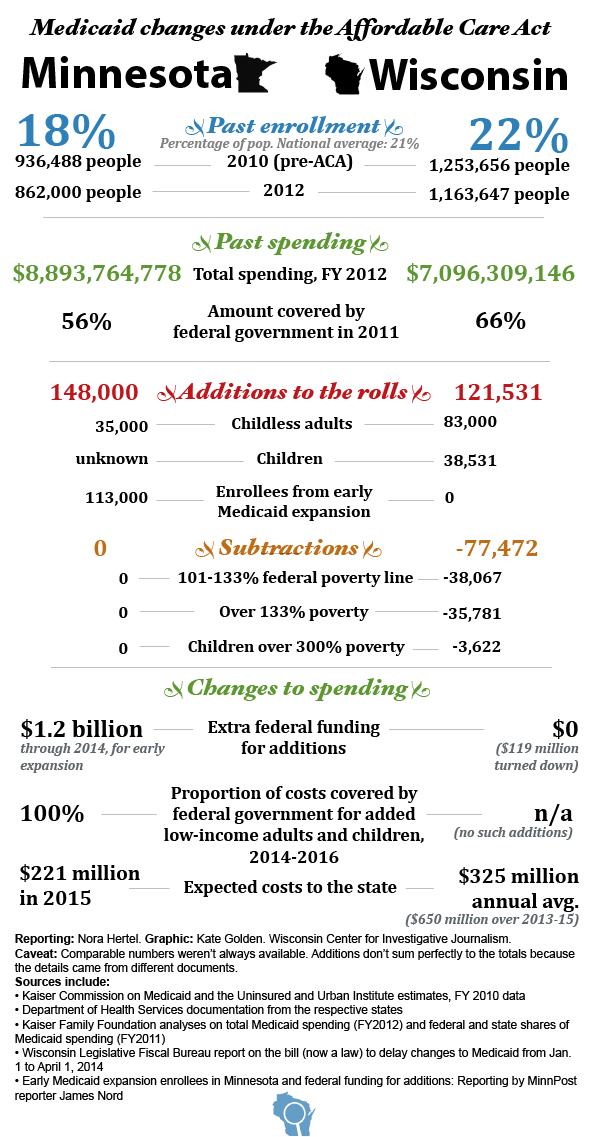Health Insurance Costs 44% Less in Minnesota
Silver tier plan under Obamacare costs $192 month in Minnesota; same coverage is $344 here.
It’s called the Affordable Care Act, but it looks as though obtaining health care coverage on the new private exchanges will generally be much more affordable in Minnesota than Wisconsin.
The lowest-cost “silver tier” plan in Minnesota will cost an estimated $192 per month, according to averages calculated by the U.S. Department of Health and Human Services in September. The same level of coverage in Wisconsin is expected to cost an average of $344.
Minnesota set up its own online marketplace — MNsure — where residents choose insurance plans. Wisconsin residents seeking coverage under the Act must use the federally run exchanges.
Progressive advocacy group Citizen Action of Wisconsin released a report comparing Badger and Gopher premiums in more detail. The report argues that policy decisions affected the difference in premium rates.
“Wisconsin’s decision to turn down enhanced federal Medicaid dollars, and its decision not to implement more robust rate review, can explain a substantial portion of the premium gap with Minnesota,” states the report, authored by Kevin Kane and Robert Kraig of Citizen Action.
The Pioneer Press in Minnesota’s twin cities of Minneapolis and St. Paul also analyzed premiums in each state along the St. Croix River. Its analysis found Minnesota rates lower than its eastern neighbor. The article chalked this up to different management of the states’ pools of people requiring high-risk insurance.
Minnesota’s high-risk pool is closing at the end of 2014 and will not accept new enrollees after Dec. 31. Wisconsin officials are closing that category of coverage under the state’s Medicaid program, BadgerCare starting April 1. Wisconsin’s Health Insurance Risk-Sharing Plan members are being directed to the private health-care exchanges. This could drive up the cost of premiums for Wisconsin residents shopping in the private market.
Minnesota is better than Wisconsin at focusing on primary care and the Twin Cities have lower health care costs than other regions because of business alliances active for two or three decades, Finkler said.
At a November conference by the Wisconsin Institute for Public Policy and Service, J.P. Wieske, public information officer for the Wisconsin Office of the Commissioner of Insurance, cautioned against Minnesota and Wisconsin comparisons.
“It’s almost not an apples-to-apples comparison,” Wieske said. “Minnesota started with a market that was different from a rate perspective than we have here… So our changes were much bigger than Minnesota’s were. There are a lot of factors.”
Related Story
The nonprofit Wisconsin Center for Investigative Journalism (www.WisconsinWatch.org) collaborates with Wisconsin Public Radio, Wisconsin Public Television, other news media and the UW-Madison School of Journalism and Mass Communication.
All works created, published, posted or disseminated by the Center do not necessarily reflect the views or opinions of UW-Madison or any of its affiliates.
-
Legislators Agree on Postpartum Medicaid Expansion
 Jan 22nd, 2025 by Hallie Claflin
Jan 22nd, 2025 by Hallie Claflin
-
Inferior Care Feared As Counties Privatize Nursing Homes
 Dec 15th, 2024 by Addie Costello
Dec 15th, 2024 by Addie Costello
-
Wisconsin Lacks Clear System for Tracking Police Caught Lying
 May 9th, 2024 by Jacob Resneck
May 9th, 2024 by Jacob Resneck






















So….the Democrats and the Doyle Administration had been screwing up the system for years while the Republican led Minnesota administration during that time fostered the relationships to better position their state to offer lower premiums…hmmmmmm…interesting.
Pawlenty may have been Governor, but he always had a DFL majority in the House and Senate.
Excuse me, but it appears that this report is using the federal subsidy to states to calculate the monthly premiums for MN, but not the federal subsidy (tax credit) to the individuals in WI. This is very disingenuous to make a comparison like that.
For example, a family of 4 in Milwaukee with 2 kids that earns $35,000 /yr would get a tax credit of $7928 year. Their monthly premium would then be $1487 a month vs almost 800 if you don’t count the tax. Thats a HUGE difference!
This VERY MISLEADING report makes it seem like people not on medicaid are high and dry.
Regardless of what you think about Government subsidies and government paid for healthcare, we don’t need reports like this confusing people and scare mongering! Citizens Action of WI should be ashamed of themselves.
Yep, I definitely started combining stories. However, the out of pocket difference between the two states for that same family, one in Milwaukee and the other in Minneapolis, is about $75. Still misleadering.
Anywho, here’s a fun tool to find more examples: http://kff.org/interactive/subsidy-calculator/
Seriously, have you asked yourself lately what the intent of this blog is?